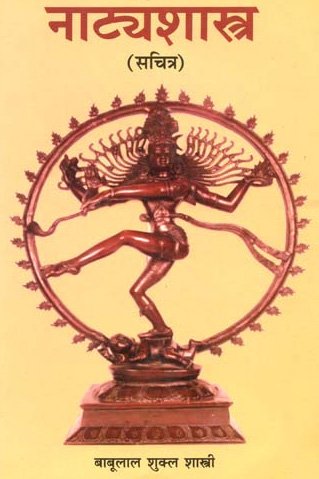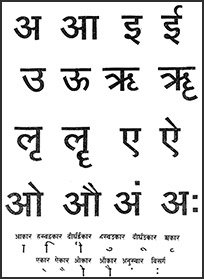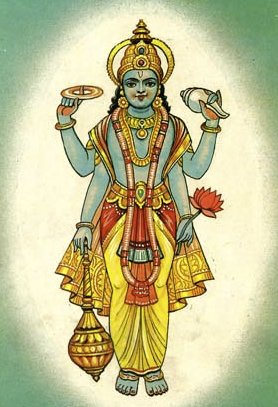Parshada, Pārṣada: 20 definitions
Introduction:
Parshada means something in Buddhism, Pali, Hinduism, Sanskrit, the history of ancient India, Hindi. If you want to know the exact meaning, history, etymology or English translation of this term then check out the descriptions on this page. Add your comment or reference to a book if you want to contribute to this summary article.
The Sanskrit term Pārṣada can be transliterated into English as Parsada or Parshada, using the IAST transliteration scheme (?).
In Hinduism
Natyashastra (theatrics and dramaturgy)
Source: Wisdom Library: Nāṭya-śāstraPārṣada (पार्षद) is the Sanskrit name of one of Bharata’s sons, mentioned in the Nāṭyaśāstra 1.26-33. After Brahmā created the Nāṭyaveda (nāṭyaśāstra), he ordered Bharata to teach the science to his (one hundred) sons. Bharata thus learned the Nāṭyaveda from Brahmā, and then made his sons study and learn its proper application. After their study, Bharata assigned his sons (eg., Pārṣada) various roles suitable to them.

Natyashastra (नाट्यशास्त्र, nāṭyaśāstra) refers to both the ancient Indian tradition (shastra) of performing arts, (natya—theatrics, drama, dance, music), as well as the name of a Sanskrit work dealing with these subjects. It also teaches the rules for composing Dramatic plays (nataka), construction and performance of Theater, and Poetic works (kavya).
Purana and Itihasa (epic history)
Source: archive.org: Shiva Purana - English TranslationPārṣada (पार्षद) refers to the “attendants” (of Śiva), according to the Śivapurāṇa 2.4.4 (“Search for Kārttikeya and his conversation with Nandin”).—Accordingly, as Kārttikeya said to Nandīśvara: “[...] O Nandikeśvara, I am not severed from the daughter of the lord of mountains who is virtually my mother just as these ladies on the basis of virtuous rites. You have been sent by Śiva. You are like a son unto Śiva. I am coming with you. I shall see the gods. After saying so and hurriedly taking leave of the Kṛttikās, Kārttikeya started along with the attendants of Śiva (śaṃkara-pārṣada)”.
Source: Cologne Digital Sanskrit Dictionaries: The Purana IndexPārṣada (पार्षद).—Śivagaṇas with awkward forms; fought with Tāraka and Māya in the battle of Tripuram.*
- * Matsya-purāṇa 135. 51, 73.

The Purana (पुराण, purāṇas) refers to Sanskrit literature preserving ancient India’s vast cultural history, including historical legends, religious ceremonies, various arts and sciences. The eighteen mahapuranas total over 400,000 shlokas (metrical couplets) and date to at least several centuries BCE.
Vyakarana (Sanskrit grammar)
Source: Wikisource: A dictionary of Sanskrit grammarPārṣada (पार्षद).—[पर्षदि भवं पार्षदम् (parṣadi bhavaṃ pārṣadam)], lit. the interpretation or theory discussed and settled at the assembly of the learned. The word is used in the sense of works on Nirukti or derivation of words as also works of the type of the Prātiśākhyās; cf. पदप्रकृतीनि सर्वचरणानां पार्षदानि (padaprakṛtīni sarvacaraṇānāṃ pārṣadāni) Nir. I. 17 and the com. of, दुर्गाचार्यः (durgācāryaḥ) cf. also पार्षदकृतिरेषा तत्रभवतां नैव लोके नान्य-स्मिन्वेदे अर्ध एकारः अर्ध ओकारो वास्ति (pārṣadakṛtireṣā tatrabhavatāṃ naiva loke nānya-sminvede ardha ekāraḥ ardha okāro vāsti) M. Bh. on I. 1. 48: see also pp. 104, 105 Vol. VII Mahābhāsya D. E. Society's edition. See पारिषद (pāriṣada).

Vyakarana (व्याकरण, vyākaraṇa) refers to Sanskrit grammar and represents one of the six additional sciences (vedanga) to be studied along with the Vedas. Vyakarana concerns itself with the rules of Sanskrit grammar and linguistic analysis in order to establish the correct context of words and sentences.
Vaishnavism (Vaishava dharma)
Source: Pure Bhakti: Brhad BhagavatamrtamPārṣada (पार्षद) refers to:—An eternal associate of the Lord. (cf. Glossary page from Śrī Bṛhad-bhāgavatāmṛta).

Vaishnava (वैष्णव, vaiṣṇava) or vaishnavism (vaiṣṇavism) represents a tradition of Hinduism worshipping Vishnu as the supreme Lord. Similar to the Shaktism and Shaivism traditions, Vaishnavism also developed as an individual movement, famous for its exposition of the dashavatara (‘ten avatars of Vishnu’).
In Buddhism
Tibetan Buddhism (Vajrayana or tantric Buddhism)
Source: academia.edu: The Structure and Meanings of the Heruka MaṇḍalaParṣadā (पर्षदा) is the name of a Ḍākinī who, together with the Vīra (hero) named Parṣad forms one of the 36 pairs situated in the Ākāśacakra, according to the 10th century Ḍākārṇava chapter 15. Accordingly, the ākāśacakra refers to one of the three divisions of the dharma-puṭa (‘dharma layer’), situated in the Herukamaṇḍala. The 36 pairs of Ḍākinīs [viz., Parṣadā] and Vīras are dark blue in color; they each have one face and four arms; they hold a skull bowl, a skull staff, a small drum, and a knife. Alternatively, the Ḍākinīs have their own marks and motions according to the taste instead of a small drum and a skull staff.

Tibetan Buddhism includes schools such as Nyingma, Kadampa, Kagyu and Gelug. Their primary canon of literature is divided in two broad categories: The Kangyur, which consists of Buddha’s words, and the Tengyur, which includes commentaries from various sources. Esotericism and tantra techniques (vajrayāna) are collected indepently.
Mahayana (major branch of Buddhism)
Source: academia.edu: A Study and Translation of the GaganagañjaparipṛcchāParṣada (पर्षद) [=Parṣad?] refers to a “congregations (of gods)”, according to the Gaganagañjaparipṛcchā: the eighth chapter of the Mahāsaṃnipāta (a collection of Mahāyāna Buddhist Sūtras).—Accordingly, “How then, son of good family, is the Bodhisattva supported by the presence of the Buddha as unhindered and uninterrupted eloquence (pratibhāna)? Son of good family, there are the Bodhisattvas’ twenty-four sorts of eloquence. What are those twenty-four? [...] 13) eloquence which is never subdued; 14) imperishable eloquence of teaching the analysis of words; 15) luminous and splendid eloquence; 16) eloquence to be praised; 17) unfailing eloquence of teaching the dharma; 18) eloquence adorned with the congregations of gods (devaparṣad-alaṃkṛta-pratibhāna); 19) eloquence of cutting off all doubts; [...]”.

Mahayana (महायान, mahāyāna) is a major branch of Buddhism focusing on the path of a Bodhisattva (spiritual aspirants/ enlightened beings). Extant literature is vast and primarely composed in the Sanskrit language. There are many sūtras of which some of the earliest are the various Prajñāpāramitā sūtras.
India history and geography
Source: Cologne Digital Sanskrit Dictionaries: Indian Epigraphical GlossaryPārṣada.—cf. Prakrit pāṣaṃḍa (CII 1), a religious community; one belonging to a parṣad or religious group. Note: pārṣada is defined in the “Indian epigraphical glossary” as it can be found on ancient inscriptions commonly written in Sanskrit, Prakrit or Dravidian languages.

The history of India traces the identification of countries, villages, towns and other regions of India, as well as mythology, zoology, royal dynasties, rulers, tribes, local festivities and traditions and regional languages. Ancient India enjoyed religious freedom and encourages the path of Dharma, a concept common to Buddhism, Hinduism, and Jainism.
Languages of India and abroad
Sanskrit dictionary
Source: DDSA: The practical Sanskrit-English dictionaryPārṣada (पार्षद).—[pārṣadamarhati aṇ]
1) A companion, an associate, attendant.
2) A train, retinue (of a god); शर्वस्य सह पार्षदैः (śarvasya saha pārṣadaiḥ) Mahābhārata (Bombay) 3.13.14.
3) One present at an assembly, a spectator, an assessor.
4) A text-book received by any particular grammatical school.
Derivable forms: pārṣadaḥ (पार्षदः).
Source: Cologne Digital Sanskrit Dictionaries: Edgerton Buddhist Hybrid Sanskrit DictionaryParṣadā (पर्षदा).—(= pariṣ°, Sanskrit parṣad; § 15.9), assembly: °dānāṃ Mahāvastu i.29.13 (prose); °dāyāṃ Suvarṇabhāsottamasūtra 21.14 (verse), so Nobel em. m.c., for pariṣ°, some mss., or v.l. parṣadi with different following text but correct meter.
Source: Cologne Digital Sanskrit Dictionaries: Shabda-Sagara Sanskrit-English DictionaryPārṣada (पार्षद).—m.
(-daḥ) 1. A spectator, a person present in a congregation or assembly. 2. A companion, an attendant. 3. A retinue, a train. E. parṣada an assembly, aṇ aff.; also with ṇya aff., pārṣadyaḥ or derived from pariṣada, pāriṣada.
Source: Cologne Digital Sanskrit Dictionaries: Benfey Sanskrit-English DictionaryPārṣada (पार्षद).—i. e. parṣad + a, m. 1. An attendant. 2. Retinue, [Harivaṃśa, (ed. Calc.)] 7252.
Source: Cologne Digital Sanskrit Dictionaries: Cappeller Sanskrit-English DictionaryPārṣada (पार्षद).—[masculine] attendant, [especially] of a god, partaker of an assembly, spectator; [neuter] text-book of a gramm. school.
Source: Cologne Digital Sanskrit Dictionaries: Aufrecht Catalogus Catalogorum1) Pārṣada (पार्षद) as mentioned in Aufrecht’s Catalogus Catalogorum:—an ancient name of the Prātiśākhya, is the eighth Pariśiṣṭa of Kātyāyana. See Kātyāyana, Ṛgveda, Vājasaneyisaṃhitā. Np. V, 62. 148. Peters. 2, 174. Sb. 75.
—[commentary] K. 184. (Uvaṭa). Np. V, 60. 62 (Vs.). P. 5. Oppert. 1903. Ii, 950. 6334 (Uvaṭa).
—[commentary] by Annambhaṭṭa, pupil of Sumaṅgala. Hall. p. 69.
2) Pārṣada (पार्षद):—See Ṛv. Taittirīya, Vs. Av. Given without accurate statement. Rādh. 1. Np. V, 40. P. 5. Proceed. Asb. 1869, 143. Oppert. 2382. 4327. 4707. 7143. Ii, 1115. 1341. 2548. 4744.
—by Kumārasvāmin q. v.
—[commentary] by Uvaṭa. NW. 14. Oudh. Xiii, 2. P. 5. Bhr. 515. 516. Poona. 11. Oppert. 1923.
Pārṣada has the following synonyms: Prātiśākhya.
3) Pārṣada (पार्षद):—a Pariśiṣṭa of Kātyāyana. Ulwar 195.
4) Pārṣada (पार्षद):—the eighth Pariśiṣṭa of Kātyāyana. Bd. 74. Peters. 6 p. 136.
Source: Cologne Digital Sanskrit Dictionaries: Monier-Williams Sanskrit-English Dictionary1) Pārṣada (पार्षद):—[from pārṣad] m. ([from] parṣad) an associate, companion, attendant ([especially] of a god), [Rāmatāpanīya-upaniṣad; Mahābhārata; Suśruta] ([plural] attendance, retinue, [Harivaṃśa; Bhāgavata-purāṇa; Lalita-vistara])
2) [v.s. ...] a member of an assembly, spectator, [Prasannarāghava]
3) [v.s. ...] n. a text-book received by any [particular] grammatical school (a Name given to the Prātiśākhyas), [Nirukta, by Yāska i, 17]
4) [v.s. ...] Name of [work]
Source: Cologne Digital Sanskrit Dictionaries: Yates Sanskrit-English DictionaryPārṣada (पार्षद):—(daḥ) 2. m. A spectator or visitant in an assembly.
[Sanskrit to German]
Sanskrit, also spelled संस्कृतम् (saṃskṛtam), is an ancient language of India commonly seen as the grandmother of the Indo-European language family (even English!). Closely allied with Prakrit and Pali, Sanskrit is more exhaustive in both grammar and terms and has the most extensive collection of literature in the world, greatly surpassing its sister-languages Greek and Latin.
Hindi dictionary
Source: DDSA: A practical Hindi-English dictionaryPārṣada (पार्षद) [Also spelled parshad]:—(nm) a councillor, senator; courtier; an attendant.
...
Kannada-English dictionary
Source: Alar: Kannada-English corpusPārṣada (ಪಾರ್ಷದ):—[noun] a member of a council, assembly, board etc.
Kannada is a Dravidian language (as opposed to the Indo-European language family) mainly spoken in the southwestern region of India.
See also (Relevant definitions)
Starts with: Parshadaka, Parshadamsha, Parshadaparishishta, Parshadapravara, Parshadashadya, Parshadashva, Parshadasutravriti, Parshadata, Parshadatika, Parshadavritti, Parshadavyakhya.
Ends with: Sarvaparshada, Shamkaraparshada, Shivaparshada.
Full-text (+50): Parshad, Parishada, Parshadata, Parshvada, Sarvaparshada, Panitaka, Parshadatika, Parshadavritti, Sarvaparshadatva, Parshadavyakhya, Parshadaparishishta, Vataganda, Maitrayaniyapratishakhya, Mahakala, Adambara, Atiyama, Lohitaksha, Atisthira, Brahmaparshadya, Parshadiya.
Relevant text
Search found 22 books and stories containing Parshada, Pārṣada, Parsada, Parṣadā; (plurals include: Parshadas, Pārṣadas, Parsadas, Parṣadās). You can also click to the full overview containing English textual excerpts. Below are direct links for the most relevant articles:
Chaitanya Bhagavata (by Bhumipati Dāsa)
Verse 1.2.25 < [Chapter 2 - The Lord’s Appearance]
Verse 2.22.1 < [Chapter 22 - Delivering Śacīdevī from Offense and Descriptions of Nityānanda’s Qualities]
Verse 2.5.53 < [Chapter 5 - Lord Nityānanda’s Vyāsa-pūjā Ceremony and His Darśana of the Lord’s Six-armed Form]
Brihad Bhagavatamrita (commentary) (by Śrī Śrīmad Bhaktivedānta Nārāyana Gosvāmī Mahārāja)
Verse 1.3.42 < [Chapter 3 - Prapañcātīta (beyond the Material Plane)]
Verse 1.5.101 < [Chapter 5 - Priya (the beloved devotees)]
Verse 1.3.84 < [Chapter 3 - Prapañcātīta (beyond the Material Plane)]
Bhajana-Rahasya (by Srila Bhaktivinoda Thakura Mahasaya)
Text 1 < [Chapter 1 - Prathama-yāma-sādhana (Niśānta-bhajana–śraddhā)]
Garga Samhita (English) (by Danavir Goswami)
Verse 3.9.19 < [Chapter 9 - The Birth of Śrī Girirāja]
Verses 2.11.27-31 < [Chapter 11 - The Liberation of Dhenukāsura]
Sahitya-kaumudi by Baladeva Vidyabhushana (by Gaurapada Dāsa)
Bhakti-rasamrta-sindhu (by Śrīla Rūpa Gosvāmī)
Verse 3.2.149 < [Part 2 - Affection and Service (dāsya-rasa)]
Verse 3.2.36 < [Part 2 - Affection and Service (dāsya-rasa)]